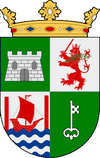| Adalbjorg I | |
|---|---|

| |
| Adalbjorg I | |
| Queen of Álengiamark | |
| Reign | March 1230 - February 1239 |
| Predecessor | Frida |
| Successor | Atamaja |
| Born | 3rd December, 1212 St. Hafdiss, Álengiamark |
| Died | 29th September, 1274 Brúvatn, Eikland, Vinland |
| Spouse | Aðalsteinn Hilmarsson |
| Issue | Dagar Aðalsteinnsson Karl Aðalsteinnsson |
| Full name | |
| Adalbjorg I Davíðsdottír | |
| House | Eiriksdottír |
| Father | Davíð Tôogosson |
| Mother | Frida |
Adalbjorg I's reign 'began badly and ended in ignominy'. This was long the accepted historical line on her reign, however that opinion is beginning to change.
The job of rescuing Adalbjorg's career and reputation is made harder due to the fact a portion of the Álengsk chronicle is missing for the beginning part of her reign. We know from Vinlandic sources that she succeeded her mother, Frida of Álengiamark, in 1230 and that by 1231 Álengiamark and much of North-East Leifia was experiencing a deep famine. When the chronicle restarts in 1232 however it appears she was getting to grips with the messy relationship of earl and town to the crown and Althing. It is unclear what exactly triggered this change in however may have had something to do with the famine and the fact that the area around St. Hafdiss, i.e. the royal domain, had suffered less than other Álengsk areas.
It would appear therefore that Adalbjorg was suddenly presented with a political scene where for once the crown had the upper hand. Buoyed by taxes and a relatively stronger personal army she made steps to strengthen the Althing. References to peasant revolts and Adalbjorg's army assisting in their suppression probably explains so of the new found co-operation, Adalbjorg no doubt withheld her support until the lords caved into her demands. Her efforts however were thoroughly condemned. The writers of the chronicle were monks from the Abbey of St. Hafdiss and therefore inevitably hostile as their Abbot's independence was restricted. This hostility probably went a long way to damage her reputation for the future.
It is fruitless game to ponder where Adalbjorg could have taken Álengiamark if her reign had not been abruptly ended in 1239. The fact is that the stubborn but weakened Álengsk nobility were confronted by a foe much more ruthless and formidable than the small divided tribes Álengiamark had hitherto fought against and proved unable to oppose them effectively.
Throughout the 1230s Edoha, Prince of Youghiogh, had campaigned amongst the disparate Aniyunwiyan territories and had succeeded in uniting them into a single 'empire'. Once this was complete in around 1235 he began directing Aniyunwiyan energies outwards, in a deliberate policy to keep his nobles from fermenting trouble at home. Rather than 'pacification' which the yearly Álengsk campaigns had aimed for, these were campaigns were for all-out conquest. The 'Battle of Seven Kings' in April 1238 destroyed Eriac, Unami and Haudenosaunee independence. Álengiamark was next in the firing line and by October Aniyunwiyan cavalry had to all intents and purposes defeated the army of Álengiamark and burnt and occupied St. Hafdiss.
Adalabjorg was captured in the burning ruins and imprisoned, formally deposed in early 1239 and was brought to Edoha's capital at Kispokotha, lest the humbled Álengsk nobility or Vinland, attempt to cause trouble. The Álengsk were not made immediate subjects of the Anyunwiyan Empire, instead humouring the Álengsk practice of having a Queen rather than a king, Edoha cynically placed his youngest daughter, the teenage Atamaja, on the Álengsk throne. Her own rule was backed by considerable military power however and Aniyunwiyan lords made swift claims on large portions of the country.
By 1240 Vinland was getting cold feet about confronting Edoha further and diplomatic discussion resulted in Adalabjorg's release from captivity. In return they gave up their claim to Ontario and in effect defined Vinland and Álengiamark's future borders. Adalbjorg was welcomed by her cousin Freydis II in 1341 and she retired to an estate, Ytrisauthfeyja, that Freydis II had given her, on the southern coast of Eikland. It is unclear what happened to some of her children. Karl, Kári and Eyrún appear to have become minor nobles in Aniyunwiyan run Álengiamark. Kári was killed during a peasant rebellion in 1248. Aðalheiður was recorded to have joined her mother at Ytrisauthfeyja. It appears Adalbjorg did not pursue any further political career, retiring from noble life to a large degree. However in her final years she was Abbess of Brúvatn convent which suggests she still had connections.
| ||||||||||||||||||||||||||||||||||
| ||||||||||||||||||||


